Sometimes, food is all about where we’re from, and sometimes, it’s all about where we want to go. My French Canadian recipes are meaningful to me, because they’re a part of the fabric of my life; they’re my history, my culture, and my memories. And I wouldn’t give them up for the world. In fact, they are a necessary part of my existence. But once in a while, I need variety. I crave the exotic, and when I haven’t traveled in a while, it feels like the only way to escape the doldrums of everyday life is to run into the kitchen and cook my way to a foreign country. Today was one of those days where I wanted something with a European flair, something I hadn’t tried before, or heard of in my corner of the world. That perfect something is this cardamom cake with whole pears and white chocolate. Cardamom is a baking spice staple in many Scandinavian countries, and I love the touch of spicy pepperiness it brings to any baked goods, especially biscotti. So I knew I was going to love this cake, because it would make me feel like I was transported to a Swedish bakery on a cold winter’s afternoon. Perfect.
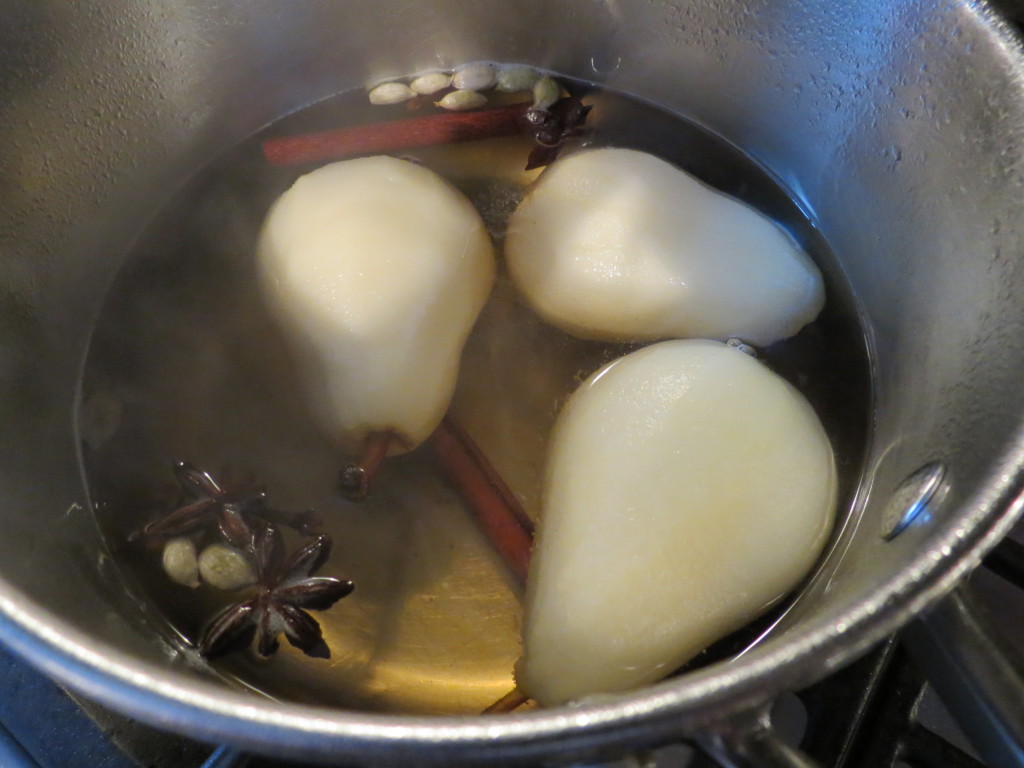
The pears are poaching gently in their wine based stock, alongside some whole spices. The house smells amazing!
Cookbooks really are a medium that allow me to travel (if only in an armchair sort of way), by allowing me to experiment with a region’s particular recipes, and create dishes or meals that truly represent a taste of life from that country. As a cookbook collector with over 500 volumes, my tastes in books range significantly. In my library, you will find a lot of French cooking, Italian cooking, everything by Nigella Lawson, nearly everything by Simon Hopkinson, Nigel Slater and Jamie Oliver. There are also a ton of baking books. And cocktail/drinks books. That must be why I also have a lot of health food recipe books too…and fitness books (but that’s another topic for another day).

Poached pears. Ready to be dunked into the cake batter. If I wasn’t making the cake, I’d pour melted chocolate all over them and call it dessert!
All this to say that my cookbook purchases have evolved over the years. For one thing, I don’t impulse buy cookbooks anymore. My already full library offers limited (ok, no more) space, and its physical constraints are a constant reminder to choose the next purchase wisely, because it tampers with my book real estate every time, forcing me to figure out how I’m going to redistribute the excess volumes. There is a very real fear that one day, I’m going to have to start donating or selling part of my collection. This is the kind of fear that keeps me up at night, wondering how best to manage the problem without having to put the house up for sale so that I can buy one with a bigger library. That, or ask Meat and Tater Man to build me some new shelving. Frankly, I’d rather write math exams than ask him to do that.
While instinctively I know when looking through a book whether or not I will buy it (and it has nothing to do with whether the book is a best seller or not), I had to think long and hard on the reasons why I will invest in a new volume (besides sheer greed, of course). The things that initially attract me most to a cookbook are simple elements, such as photography, layout, and pictures for all or most of the recipes. But what really draws me in for the purchase are elements that are harder to explain – writing style, content, themes, how the chapters have been sorted, the type of cookbook (and how many of these types I currently own), and how personal the story writing is. I don’t necessarily seek out writers that talk about their family secrets (though I find it strangely satisfying to read about famous people’s family affairs), but I do connect with food writers that have “a story” about the recipe they’re presenting. It’s not just about ingredients – I get that, but it goes deeper than that. The story (or recipe header) has the power to draw me to try something in the kitchen. And that story can be anecdotal, personal, hilarious, or simply too compelling for words to describe. This is what I look for – the recipe’s raison d’etre, and the author’s plug on why I, the reader, need to try it.
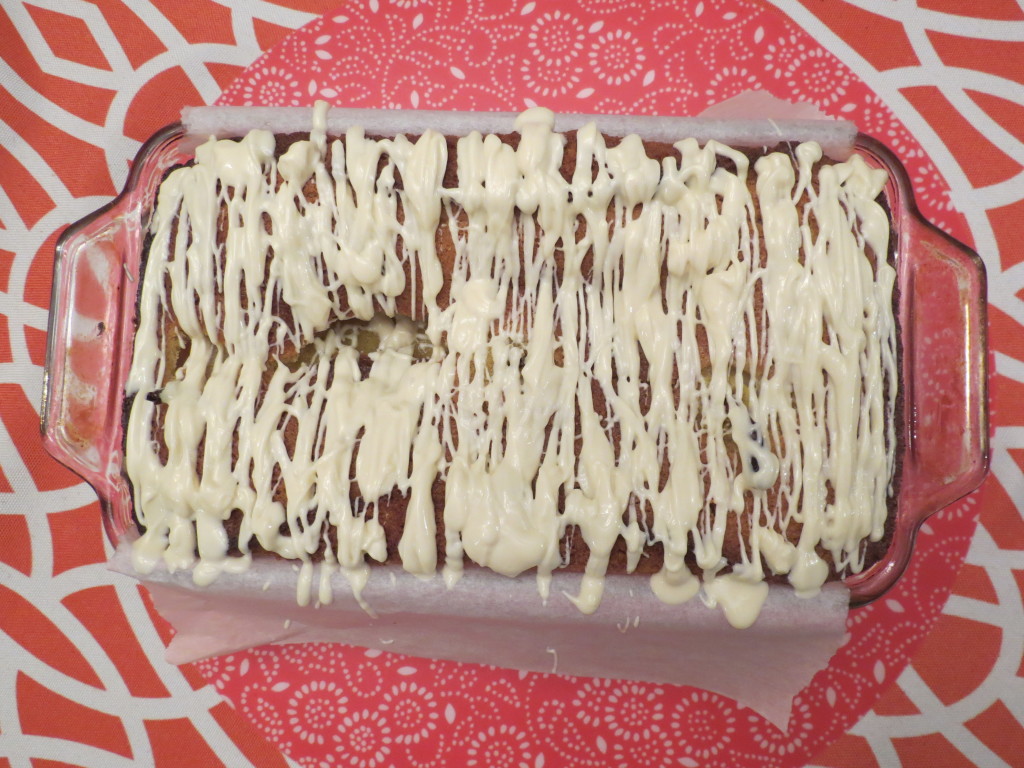
Let’s talk about glazing shall we? Melt three ounces of white chocolate, then pour over the cake. Easy. Amazing. Tastes out of this world. Did I mention easy?
One of the authors that really has the power to draw me in with her stories is Yvette Van Boven. Upon instantly picking up her book, Winter, I fell in love. Her recipes are gathered and presented in a rather eclectic way throughout each chapter, and many of them are illustrated in hand print – a touch I love. The photography is fabulous (as it should be when your husband is your photographer), highlighting not only pictures of finished recipes, but step by step shots, and pictures of the beautiful landscapes of Europe. Yvette is of Dutch origin, but grew up in Ireland and now spends much of her time in France, so the content of her books is as diverse as her background, and this is one of the reasons why her books work so well for me. Many of her recipes are totally new to me, and I love the variety of recipes she brings in each of her books.
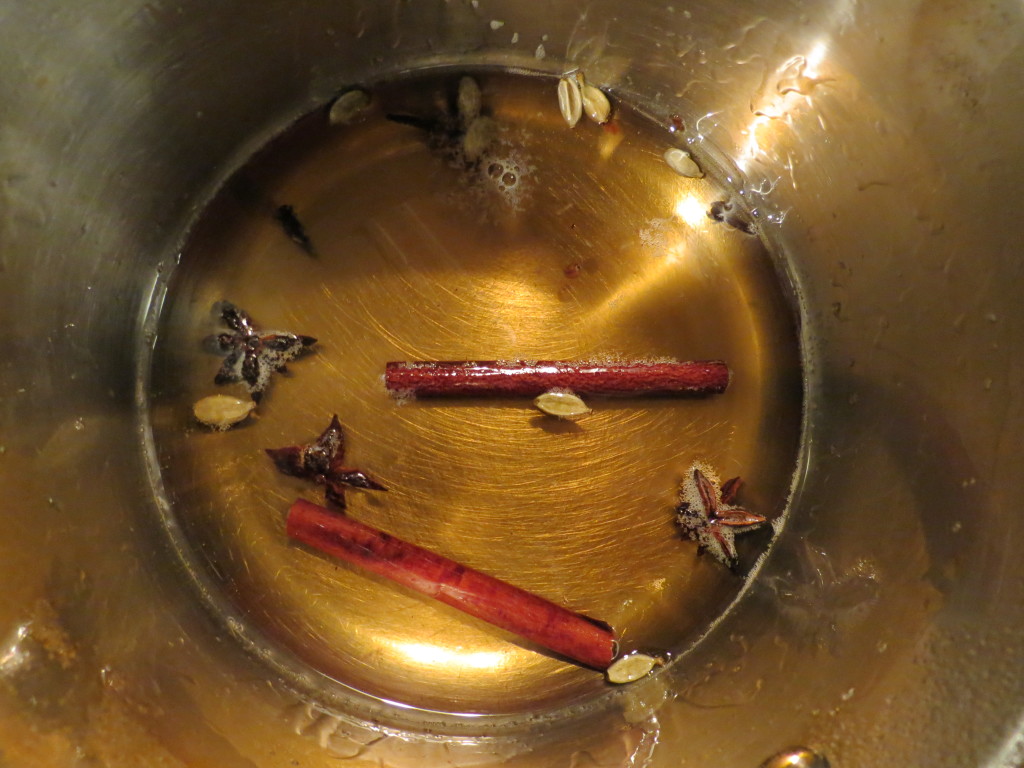
Taking the leftover poaching liquid, and reducing it to a syrup to pour over the sliced cake is genius. Oh, and have I mentioned that a small spoonful of this syrup poured into a glass of bubbly or wine would also be fabulous?
This recipe for cardamom cake is, according to Yvette, a commonly published magazine recipe in Europe, though I had never seen this until I opened her book. I immediately fell in love with the ingredients – white chocolate, wine and spice poached pears, and a basic pound cake recipe with cardamom. What could be better? Upon first glance at the recipe, I did find some flaws in the imperial to metric conversions, but I adapted accordingly, and got good results. Here is her recipe, adapted to work properly. Despite the editing flaws, I still highly recommend the book…it is beautiful, and filled with wonderful stories and fabulous recipes from all over the world. Yvette’s personality really shines through, page after page, and you’re left wanting to head to the kitchen each time you open the book and read a few of its pages.
This is Yvette Van Boven's recipe from her lovely cookbook, Winter. The ingredient ratios were out of proportion, so I doctored the numbers in order to get the results I wanted, and it worked.
The original recipe doesn't call for coring the pears, but I find it so much easier to eat fruit that has been pitted and/or stoned, so I highly recommend removing the pears' core before using them in the recipe. It also asked for a whole bottle of wine to poach the pears, but I took a more economical approach by using half water and half wine, and had no regrets.
It also called for a generous tablespoon of ground cardamom, and I (sheepishly) reduced this to two teaspoons. I thought the whole tablespoon would make the cake taste too peppery, and I might have been right. At any rate, I found the two teaspoons of cardamom to be just right for my tastes.
My last change was to convert self-rising flour by using all purpose flour instead, and adding some baking powder.
The recipe calls for baking for exactly 40 minutes, which I did, however, I have a very hot oven, so you may need to bake this for an extra 5 minutes or so to make it just right.
Ingredients
- For the pears:
- 3 medium-sized crisp, firm pears (such as Bosc), peeled but whole, with the stem left on, and the cores removed (I used a melon baller to scoop out the cores from the bottom of each pear)
- 1 1/2 cups dry white wine
- 1 1/2 cups water
- 1 1/4 cups sugar
- 4 cloves
- 3 star anise
- 8 cardamom pods
- 2 cinnamon sticks
- For the cake:
- 2 sticks (8 oz) plus 2 tbsp butter, softened, plus extra for greasing the pan
- 1 cup sugar
- 4 eggs
- 1 1/2 cups all purpose flour
- 2 tsp baking powder
- 2 tsp ground cardamom
- 1/2 tsp salt
- 3 oz white chocolate, in chunks
Instructions
- Poach the pears: In a large saucepan, combine the pears, wine, sugar, cloves, star anise, cardamom, and cinnamon and poach for 30 minutes over low heat.
- Take the pears out of the liquid and set aside to cool. Add 1/2 cup water to the poaching liquid and boil to reduce the liquid by half. Let cool.
- Make the cake: Preheat the oven to 350°F.
- Using a hand mixer, beat the butter and sugar in a large bowl until creamy. Beat in the eggs one at the time. Don’t add a new egg until the previous one is incorporated.
- Sift the flour, baking powder, cardamom, and salt over the batter and fold it in.
- Grease a 9-by-5-inch loaf pan and line it with parchment paper. Grease the parchment paper with softened butter.
- Spoon the batter into the pan. Press the pears in, stem end up. Bake for 40 to 45 minutes, or until a toothpick inserted into the cake part comes out clean.
- Allow to cool in the pan, then gently remove the cake from the pan to a rack to cool completely. (I left the cake in the pan, and frosted it in the pan, but if you would like to serve the cake whole, table side, I suggest you remove it from the pan before frosting it with the chocolate.)
- Very carefully melt the chocolate: Set a heatproof bowl over a pan of simmering water, making sure the bowl doesn’t touch the water. Stir the chocolate in the bowl until melted. Using a spoon, drizzle the chocolate over the cake and create nice stripes on top.
- Let the chocolate dry for a bit and serve the cake in thick slices, with the reduced pear syrup poured on top.


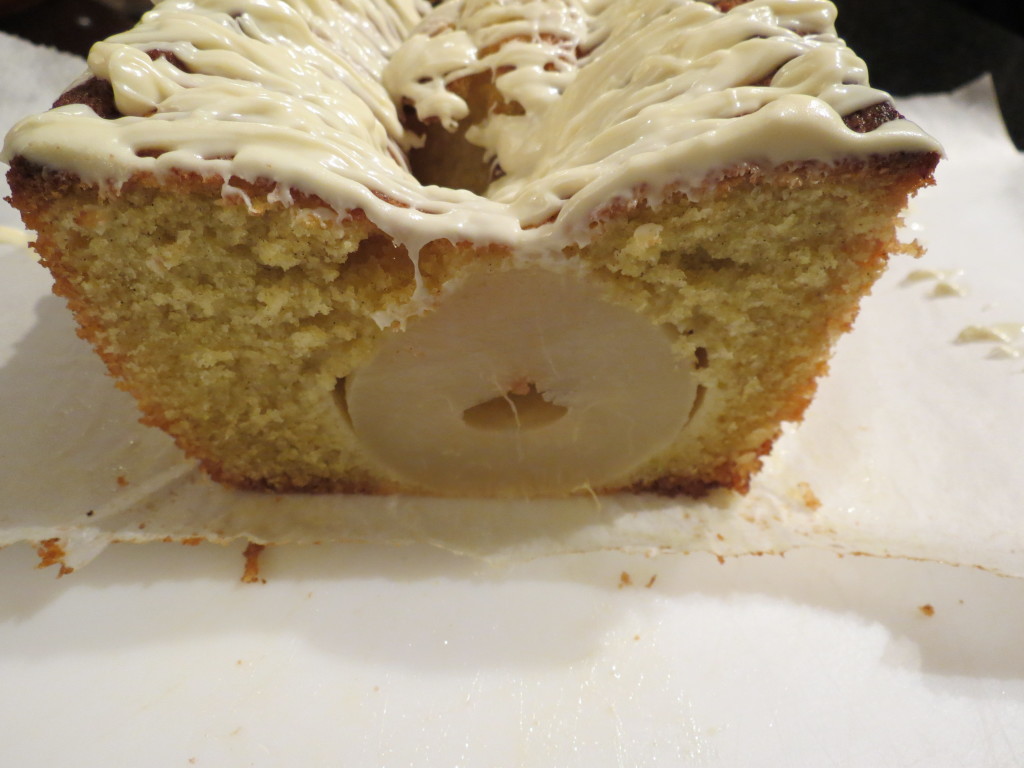
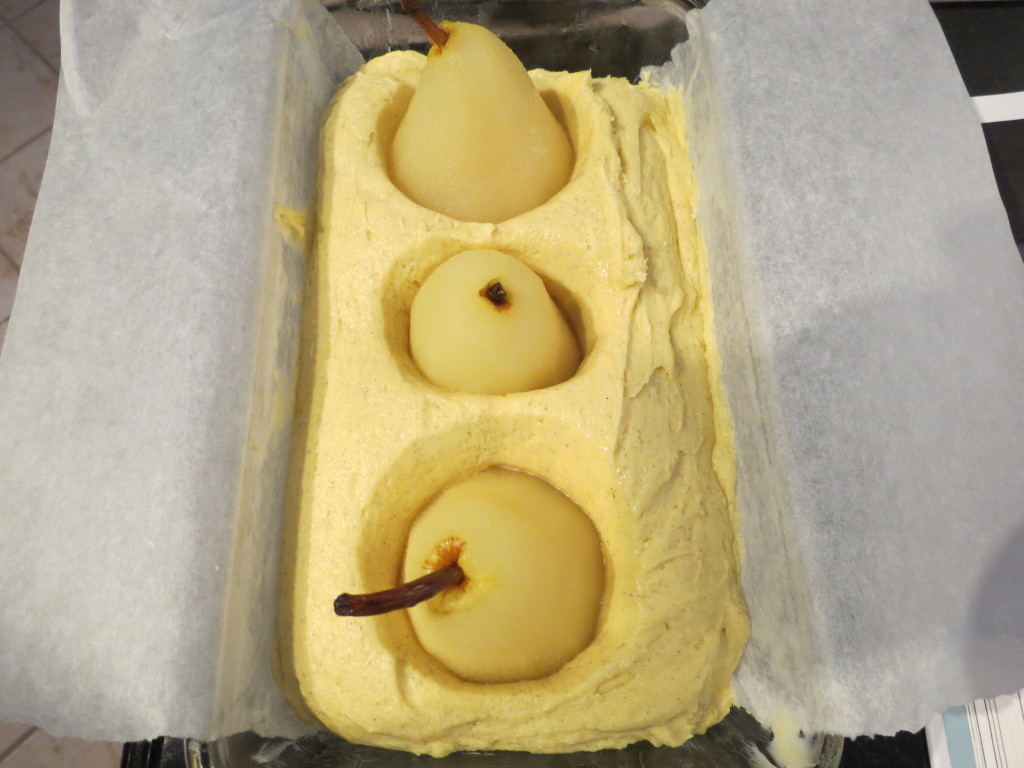
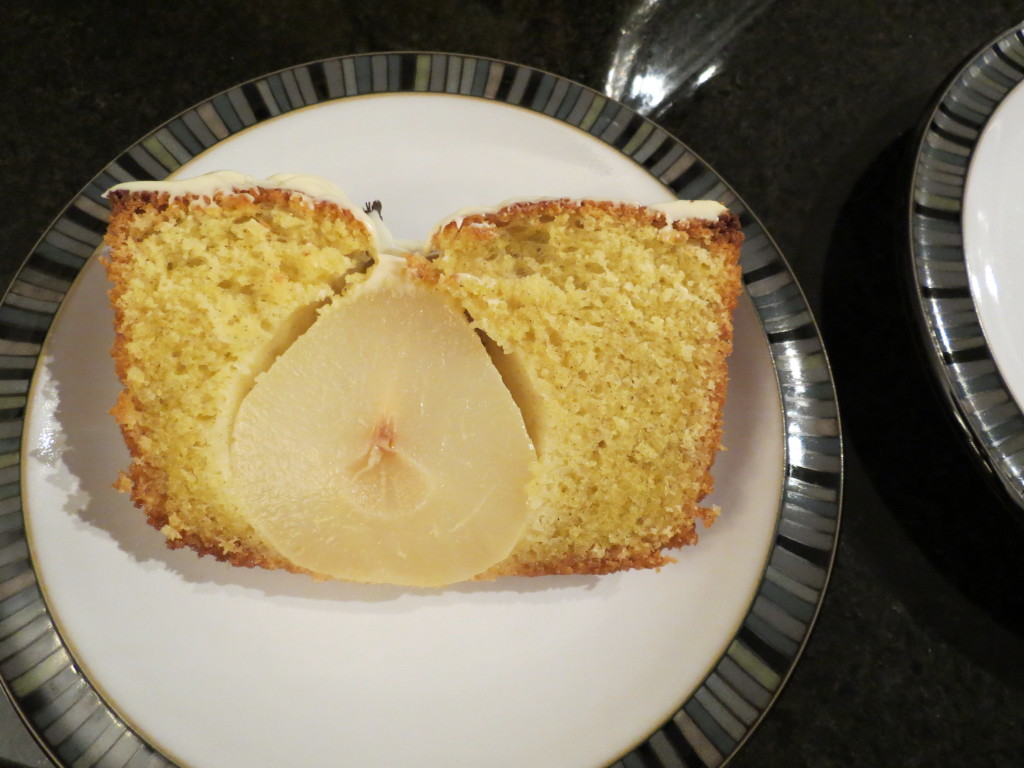

Leave a Reply